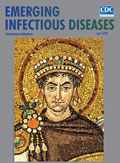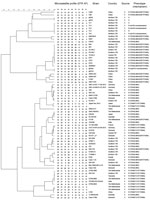
Volume 26, Number 4—April 2020
Research Letter
Multicenter Study of Azole-Resistant Aspergillus fumigatus Clinical Isolates, Taiwan1
On This Page
Figures
Article Metrics
Chi-Jung Wu, Wei-Lun Liu, Chih-Cheng Lai, Chien-Ming Chao, Wen-Chien Ko, Hsuan-Chen Wang, Ching-Tzu Dai, Ming-I Hsieh, Pui-Ching Choi, Jia-Ling Yang, and Yee-Chun Chen
Abstract
In a multicenter study, we determined a prevalence rate of 4% for azole-resistant Aspergillus fumigatus in Taiwan. Resistance emerged mainly from the environment (TR34/L98H, TR34/L98H/S297T/F495I, and TR46/Y121F/T289A mutations) but occasionally during azole treatment. A high mortality rate observed for azole-resistant aspergillosis necessitates diagnostic stewardship in healthcare and antifungal stewardship in the environment.
Worldwide emergence of azole-resistant Aspergillus fumigatus since the late 2000s threatens human health (1). Azole resistance in A. fumigatus might develop during patient therapy with medical azoles or through exposure to azole fungicides in the environment; environmental exposure predominantly involves TR34/L98H and TR46/Y121F/T289A mutations in cyp51A (1).
Taiwan is an island country in eastern Asia that is geographically separated from mainland Eurasia and has a long history of azole fungicide use. To delineate the influence of clinical and environmental use of azoles on resistance, we conducted a multicenter study that investigated 375 A. fumigatus sensu stricto isolates collected during August 2011–March 2018 from 297 patients at 11 hospitals in Taiwan (Appendix Table 1, Figure 1).
We confirmed the presence of azole resistance by using the Clinical Laboratory Standard Institute method (Appendix Table 1) (2). Isolates resistant to >1 medical azoles (itraconazole, voriconazole, posaconazole, and isavuconazole) were defined as azole-resistant A. fumigatus and examined for resistance mechanisms, microsatellite-based phylogenetic relatedness, and growth rates following previously described methods (3,4).
Overall, 19 isolates from 12 patients were azole-resistant A. fumigatus. These isolates had resistance rates of 4.0%/patient and 5.1%/isolate analyses (Appendix Tables 2, 3). Ten (83.3%) patients harbored azole-resistant A. fumigatus that had environmental mutations, including TR34/L98H (5 isolates, 5 patients), TR34/L98H/S297T/F495I (7 isolates, 4 patients), and TR46/Y121F/T289A (1 isolate) mutations. This observation is consistent with the estimated global prevalence of azole resistance in Aspergillus (3%–6%) and the predominance of environmental resistance mechanisms in azole-resistant A. fumigatus (1,5).
Phylogenetic analysis showed that TR34/L98H/S297T/F495I isolates from 2 patients with pulmonary aspergillosis (isolates B44 and B51 in 2012, isolates E071, E073, and E074 in 2015) (Figure) belonged to a local microsatellite genotype widely distributed in the environment of Taiwan (3), indicating that this clone has locally evolved and adapted to the environment. The TR34/L98H isolates were genetically clustered with local environmental isolates or clinical isolates from China and Europe (Appendix Table 4). The TR46/Y121F/T289A isolate (S05–322) recovered in 2018, which colonized a patient without overseas travel, was genetically identical to a clone prevalent in the Netherlands and Tanzania (6), raising the concern of the intercountry transfer of resistant isolates.
All TR34/L98H/S297T/F495I, TR34/L98H, and TR46/Y121F/T289A isolates exhibited cross-resistance to difenoconazole and tebuconazole (both triazole fungicides) without fitness cost, demonstrated by normal growth rates (Appendix Figure 2). The TR34/L98H/S297T/F495I isolates and TR46/Y121F/T289A isolates were also resistant to prochloraz (an imidazole fungicide) (Appendix Table 2). The prevalence of TR34/L98H/S297T/F495I isolates in Taiwan might be attributed to widespread use of prochloraz over the past 3 decades. Studies have suggested an association between use of imidazole fungicides and emergence of azole-resistant A. fumigatus with TR34/L98H/S297T/F495I mutations (7,8).
In Taiwan, the annual consumption of difenoconazole and tebuconazole has exceeded that of prochloraz since 2012 (Appendix Figure 3), further creating a favorable environment for maintenance and spread of TR34/L98H, TR34/L98H/S297T/F495I, and TR46/Y121F/T289A isolates. Thus, the One Health approach to implement environmental antifungal stewardship is warranted to minimize ongoing resistance selection in the fields.
Six azole-resistant A. fumigatus isolates with wild-type cyp51A were obtained from 2 patients. Four pan–azole-resistant urinary isolates were sequentially recovered from a patient (no. 11) with A. fumigatus renal abscesses who was receiving voriconazole for >3 months in whom an initial urine isolate was susceptible to azole; all 5 isolates were genetically identical.
Overexpression of cdr1B (a drug efflux transporter) and an S269P mutation in hmg1 (a hydroxymethylglutaryl-CoA reductase) were identified in 4 resistant isolates but not in the initial susceptible isolate (Appendix Table 5, Figure 4), suggesting their roles involved in azole resistance (4,9). Another 2 pan–azole-resistant respiratory isolates were recovered from a patient (no. 12) who had pulmonary aspergillosis and was receiving voriconazole for 4 months. Azole-susceptible and azole-resistant isolates co-existed in this patient, which echoes the international recommendation suggesting testing multiple colonies (>5) from a single culture (1). Cyp51A overexpression and an F262 deletion in hmg1(hmg1F262_del) were identified in these 2 resistant isolates. Although hmg1F261_del was recently reported in azole-resistant A. fumigatus from a voriconazole-exposed patient (4), whether cyp51A overexpression and hmg1F262_del act synergistically to cause resistance warrants further studies.
Finally, reduced colony sizes were observed in all 6 azole-resistant A. fumigatus isolates with wild-type cyp51A (Appendix Figure 2). Thus, attention should be paid to select colonies of various sizes for susceptibility testing from patients with azole exposure.
Overall, 4 patients harboring azole-resistant A. fumigatus with environmental mutations and 2 patients harboring azole-resistant A. fumigatus with wild-type cyp51A showed development of invasive aspergillosis, and all had aspergillosis-related deaths. High mortality rates for azole-resistant aspergillosis we observed (6/6, 100%) and for those from a previous report (10) emphasize the need for a proposed integrated algorithm for management and control of azole-resistant aspergillosis (Appendix Table 6).
In conclusion, we report a health threat that arose from clinical and environmental use of azoles; environmental use contributed at a larger and global scale. These data necessitate diagnostic stewardship in the clinic and antifungal stewardship in the environment.
Dr. Wu is an assistant investigator and attending physician at National Health Research Institutes, Zhunan, Taiwan. Her research interests include molecular epidemiology of infectious diseases and antimicrobial drug resistance in bacterial and fungal pathogens.
Acknowledgments
We thank Cheng-Chen Cheng, Li-Fang Chen, Li-Yu Yang, and Ya-Feng Wu for laboratory assistance; Hui-Chun Chang for collecting clinical information; and the following hospitals for sharing Aspergillus spp. clinical isolates: Changhua Christian Hospital, Chi Mei Medical Center-Liouying, Chung Shan Medical University Hospital, Ditmanson Medical Foundation Chia-Yi Christian Hospital, Far Eastern Memorial Hospital, Hualien Tzu Chi Hospital, Kaohsiung Chang Gung Memorial Hospital, Kaohsiung Medical University Chung-Ho Memorial Hospital, Kaohsiung Veterans General Hospital, Mennonite Christian Hospital, National Cheng Kung University Hospital, National Taiwan University Hospital, Show Chwan Memorial Hospital, Taichung Veterans General Hospital, Tainan Sin Lau Hospital, and Taipei City Hospital Heping Fuyou Branch.
This study was supported by the National Health Research Institutes of Taiwan (grants IV-105-PP-08 and IV-106-PP-08), the Ministry of Science and Technology of Taiwan (grants MOST 105-2628-B-400-004-MY2), and Gilead Sciences, Inc. (grant IN-US-131-3918).
Y.-C.C. has received honoraria for speaking and advisory board membership from Pfizer, Gilead, Merck, and Astellas, and was involved as a steering committee member of regional education programs at Gilead (Asia CARE) and Pfizer (Medical Mycology Training Network). W.-LL. has received honoraria for speaking from Pfizer and Gilead.
References
- Verweij PE, Ananda-Rajah M, Andes D, Arendrup MC, Brüggemann RJ, Chowdhary A, et al. International expert opinion on the management of infection caused by azole-resistant Aspergillus fumigatus. Drug Resist Updat. 2015;21-22:30–40.
- Clinical and Laboratory Standards Institute. Reference method for broth dilution antifungal susceptibility testing of filamentous fungi: approved standard, 2nd ed. M38–A2. Wayne (PA): The Institute; 2008.
- Wang HC, Huang JC, Lin YH, Chen YH, Hsieh MI, Choi PC, et al. Prevalence, mechanisms and genetic relatedness of the human pathogenic fungus Aspergillus fumigatus exhibiting resistance to medical azoles in the environment of Taiwan. Environ Microbiol. 2018;20:270–80.
- Hagiwara D, Arai T, Takahashi H, Kusuya Y, Watanabe A, Kamei K. Non-cyp51A azole-resistant Aspergillus fumigatus isolates with mutation in HMG-CoA reductase. Emerg Infect Dis. 2018;24:1889–97.
- Arendrup MC. Update on antifungal resistance in Aspergillus and Candida. Clin Microbiol Infect. 2014;20(Suppl 6):42–8.
- Chowdhary A, Sharma C, van den Boom M, Yntema JB, Hagen F, Verweij PE, et al. Multi-azole-resistant Aspergillus fumigatus in the environment in Tanzania. J Antimicrob Chemother. 2014;69:2979–83.
- Chen YC, Lai MH, Wu CY, Lin TC, Cheng AH, Yang CC, et al. The genetic structure, virulence, and fungicide sensitivity of Fusarium fujikuroi in Taiwan. Phytopathology. 2016;106:624–35.
- Chen Y, Li Z, Han X, Tian S, Zhao J, Chen F, et al. Elevated MIC values of imidazole drugs against Aspergillus fumigatus isolates with TR34/L98H/S297T/F495I mutation. Antimicrob Agents Chemother. 2018;62:e01549–17.
- Fraczek MG, Bromley M, Buied A, Moore CB, Rajendran R, Rautemaa R, et al. The cdr1B efflux transporter is associated with non-cyp51a-mediated itraconazole resistance in Aspergillus fumigatus. J Antimicrob Chemother. 2013;68:1486–96.
- van der Linden JW, Snelders E, Kampinga GA, Rijnders BJ, Mattsson E, Debets-Ossenkopp YJ, et al. Clinical implications of azole resistance in Aspergillus fumigatus, The Netherlands, 2007-2009. Emerg Infect Dis. 2011;17:1846–54.
Figure
Cite This ArticleOriginal Publication Date: 3/5/2020
1Results from this study were presented in part at the 30th International Congress of Chemotherapy and Infection, November 24–27, 2017, Taipei, Taiwan.























.png)











No hay comentarios:
Publicar un comentario